Coleus Care: How to Grow Colorful Coleus Plant Indoors and Outdoors

Coleus plants are well-known for their beautiful foliage that enhance garden borders and brighten up rooms as potted houseplants. All types of coleus are easy to care for if they get enough light and moisture. Their leaves come in all sorts of colors, such as yellow, purple, lime green, dark red, and bright pink. Some variegated varieties have stunning combinations of contrasting colors.
Coleus plant care: Coleus houseplants need bright, indirect sunlight and grow in containers with a well-draining potting mix. Water to keep the soil slightly moist and keep humidity levels high. Keep in temperatures of 65°F to 75°F (24°C – 27°C) and protect from frost. Apply fertilizer weekly to the potting soil and prune to encourage bushy growth.
If you are growing coleus plants outdoors—either in the ground or in containers—the same care instructions apply. Plant the coleus in bright locations with partial shade and ensure that soil is always moist and never too damp or soggy. Because coleus plants need warm weather, growing them in pots outside allows you to take them indoors in winter.
With the proper care, a coleus plant in a large container can grow up to 3 ft. (0.9 m) tall. Regular pruning can help control height and, at the same time, promote a fuller, bushy appearance.
In this article, you will find out how to care for coleus as an indoor houseplant or outdoors as a colorful border plant. At the end of the article, you will find out about some of the gorgeous coleus plants you can grow at home.

Coleus plants come in a stunning array of colors
Is Coleus a Perennial or Annual?
Coleus plants (genera Plectranthus and Solenostemon) are flowering evergreen perennials. Coleus is a tropical plant that will come back year after year if you live in USDA zones 10 or 11.
However, coleus plants are classed as tender perennials and are sensitive to frost. So, most people grow coleus in their yard as annuals or as tropical evergreen houseplants in pots. As already mentioned, coleus plants thrive in containers if you have them outdoors in summer and bring them indoors in the fall and winter.
Coleus Plant Care Overview
Also known as Painted Nettle, coleus plants are easy to care for, even if you are a beginner. The evergreen ornamental houseplant thrives when planted in containers and placed in a bright room. Soil should be moist, and you need to increase humidity to mimic their native environment.
Growing Coleus Plant Indoors
Let’s look at how to achieve the ideal conditions for growing coleus plants indoors.
Coleus Care: Light Requirements
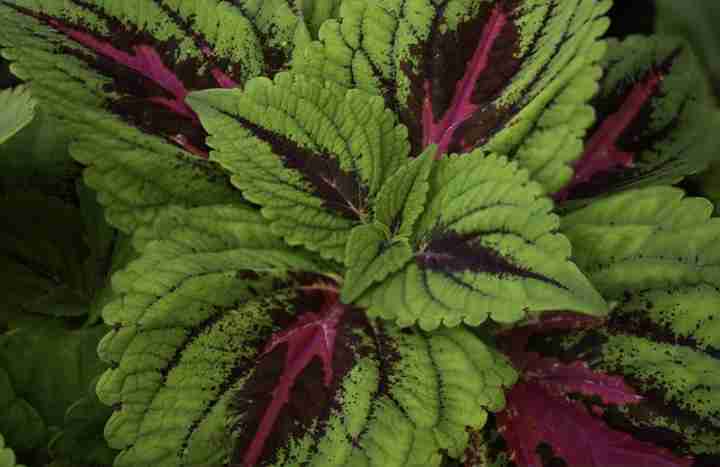
In the picture: coleus ‘kong red’
Coleus plants grow best indoors when they get bright, indirect light. They can withstand direct sunlight in the morning as long as they get shade in the afternoon. Usually, placing a potted coleus plant on a west-facing windowsill ensures enough light. Make sure that the plant is shaded if placed near a south- or east-facing window.
Although growing a coleus plant indoors is straightforward, they can be picky when it comes to sunlight. Too much direct sunlight will result in scorched leaves. You may also notice that sunlight causes the vibrant red, orange, purple, or pink leaves to fade. If the leaves start losing their color, move the container to a less sunny location.
Too much shade also isn’t suitable for your coleus plants. A lack of sunlight—for example, in dark winter days—can cause stems to wilt and leaves to fall off. To help revive a wilting coleus plant, move to a brighter location or supplement with artificial light.
Best Temperature for Coleus Plants
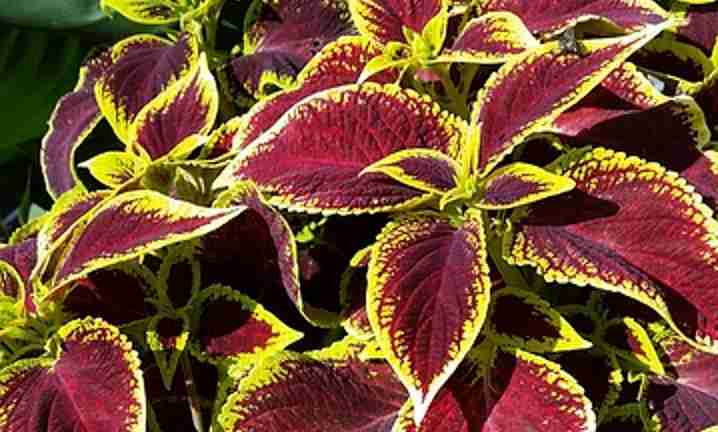
Coleus ‘wizard scarlet’
Being a tropical perennial plant, all varieties of coleus plants grow in average room temperatures. Coleus plants need temperatures of between 65°F and 75°F (24°C – 27°C). The best care tip is to avoid sudden changes in temperature and protect them from frost.
Make sure that your tropical plants are not placed in a cold draft. Unsuitable places are near an open window, air conditioning vent, or drafty door. Direct heat isn’t great for your plant either. So, keep your houseplants away from radiators, furnaces, or other sources of heat.
A bright windowsill can provide enough light if the plant is shaded from direct sunlight. However, in wintertime, the cold from the window at night could also stress your plant.
Coleus Humidity Needs
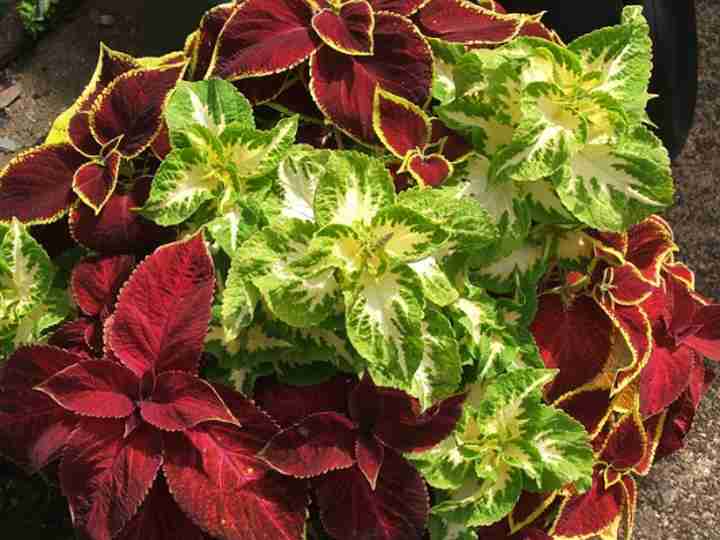
Coleus plants – rainbow mixed colors
Most tropical plants need high humidity levels to survive, and the coleus plant is no exception. Average households aren’t humid enough for moisture-loving coleus plants. The best way to care for proper humidity levels is to sit the pot on a pebble tray or use an air humidifier.
Here is how to use a pebble tray: Put a layer of pebbles in a dish and pour in enough water so it’s halfway up the stones. Place the coleus container on the pebbles, making sure the pot doesn’t touch the water. Evaporation from the water helps increase humidity for your coleus to thrive.
Apart from using a room humidifier, placing a few houseplant pots together can also boost humidity.
Signs that room air is too dry for your coleus are crispy leaves that develop brown tips.
Unlike other tropical houseplants that require daily misting, you should avoid spritzing your coleus leaves. The water can leave marks on the velvety foliage and spoil the plant’s appearance.
Best Soil for Coleus Plants
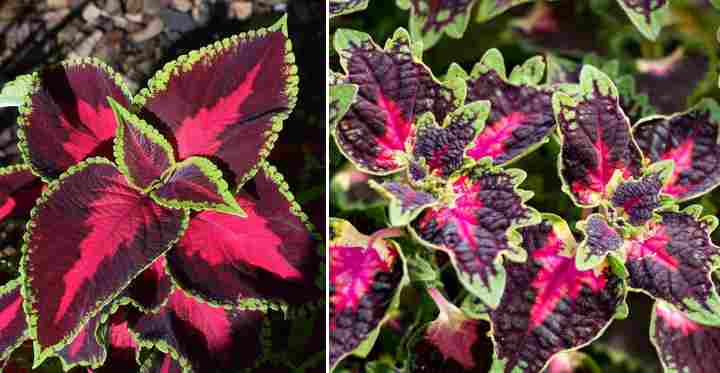
The red, purple and green foliage of these coleus plants are a focal point in any home or garden
Plant coleus in well-draining potting soil that allows enough oxygen to circulate and keep your plant healthy. The best kind of soil should contain a mixture of peat moss, perlite, or pine bark. This type of potting medium holds just enough moisture without becoming overly mushy.
The same care advice is actual for planting coleus in your yard—make sure that water drains quickly from the soil.
When choosing suitable soil for your container, a commercial, all-around potting mix should be adequate. Soil for specific plants such as succulents may be too acidic or rich for coleus.
The most critical care advice when it comes to container soil is to make sure it drains well.
Watering Your Coleus Plant
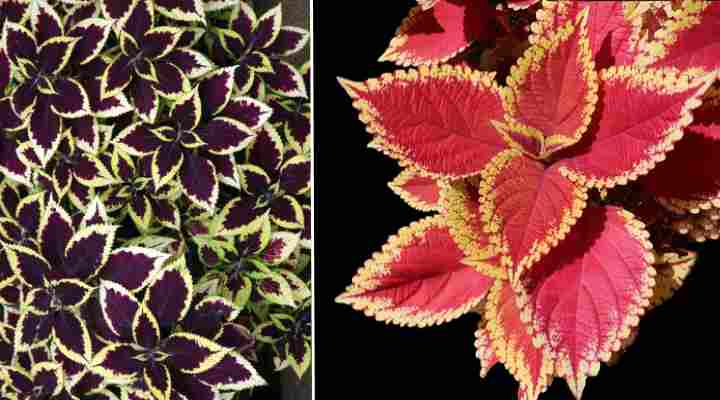
Coleus plant care requires moist soil but avoid over-watering to prevent soggy soil
Coleus is a thirsty plant and needs regular watering to keep the soil moist, but not soggy. During the growing season—April to September—water whenever the top 1” (2.5 cm) of the potting mix is dry. The frequency when you need to water your plant depends on air temperature, the type of pot, and plant growth.
During winter, you still need to water coleus, but less frequently. The general rule is to only water when the top part of the soil has dried out.
To water coleus, use water at room temperature. Pour enough water in the pot so that it drains out the bottom. Only when the water has stopped dripping should you return the container to its saucer.
Proper watering is key to preventing diseases such as root rot and fungal or bacterial issues in the soil.
Here are two top tips for caring for your coleus plant when it comes to watering:
- Let the water sit out for a day or two before using it. This allows chlorine to evaporate and prevents harming your delicate tropical plant.
- Avoid splashing water on the foliage as it can leave permanent water spots.
Fertilizer Needs
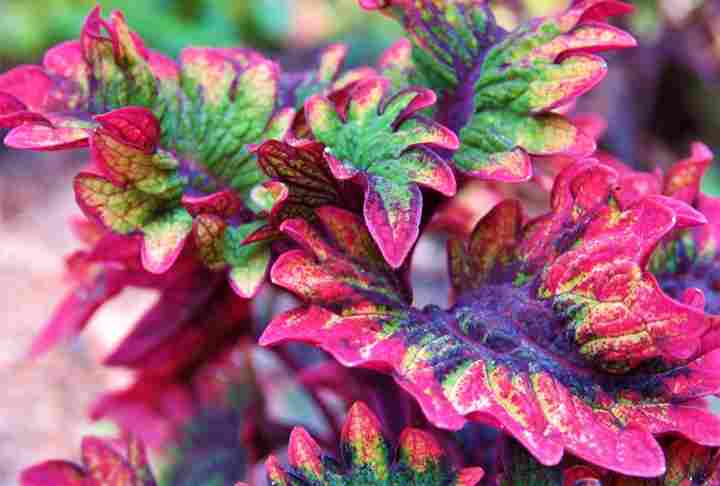
Avoid fertilizing coleus plants during winter time
Feed with diluted, half-strength all-purpose houseplant fertilizer every one to two weeks during the growing season. Caring for your plant with the right nutrients keeps its colorful foliage vibrant and healthy. Don’t fertilize plants during winter when growth becomes dormant.
Most people grow coleus plants for their pink, red, yellow, or orange leaves. To promote vivacious colors, use a diluted fertilizer that is rich in nitrogen and low in phosphorus. Avoid balanced fertilizers as they tend to encourage flowering which will take nutrients from the plant.
Read on to find out why you want to prevent your coleus from flowering.
Coleus Plant Flowers
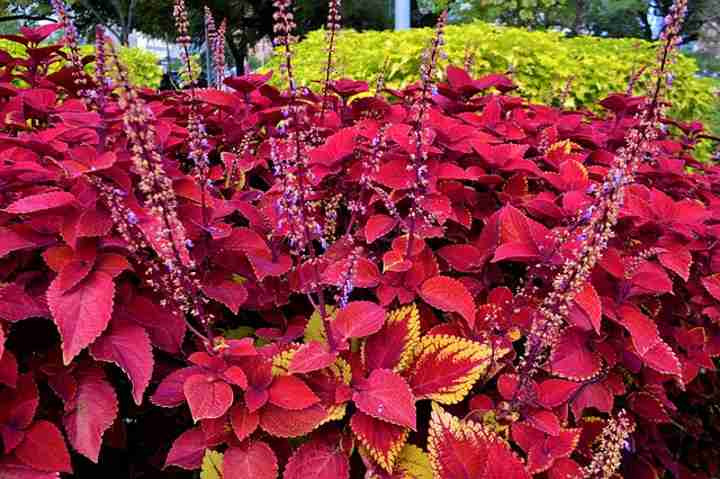
In the picture: coleus flowers that look like spikes of tiny white or purple flowers
Plants from the families Solenostemon and Plectranthus are flowering tropical plants. They produce flowering stems with small clusters of white or purple flowers. Coleus only flowers under ideal conditions, and rarely do these potted plants flower indoors.
If indoor coleus houseplants flowers, they go to seed and then die. So, if you notice flower buds starting to appear, pinch them off immediately. Keep doing this until no more buds appear. Pinching off flowers is one way to help your coleus plant live longer indoors.
Pruning Coleus Plants

Regularly prune your coleus plant to encourage bushy growth
Coleus requires regular pruning to encourage growth and prevent your plant stems from becoming leggy. The best time to prune your plant is in spring and summer; however, coleus can take pruning at any time. Pinch with your fingers or snip the stems with sheers just above the leaf nodes.
Coleus plants are similar to other tropical houseplants, such as polka dots or nerve plants. Vigorous pruning encourages bushy growth and a healthier plant.
How to Propagate a Coleus
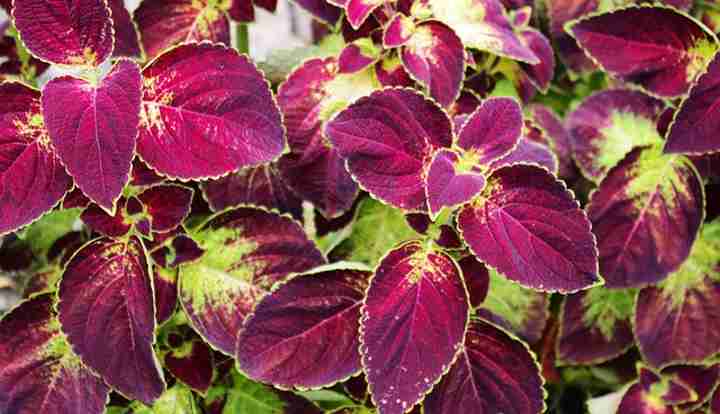
Propagate your coleus plant from stem cuttings
Cut a stem just below the leaf node, so you have a stem 3” to 4” (7.5 – 10 cm) long. There should be at least three leaves on the stem. You can root a stem cutting in water. Put your propagation stems in a jar of water and leave until roots about 1” (2.5 cm) long appear.
Transfer the rooted coleus stems to a small pot that contains a well-draining potting mix.
You can also have success propagating coleus by placing the end of the cut stem in rooting hormone and then planting directly in the soil.
Repotting
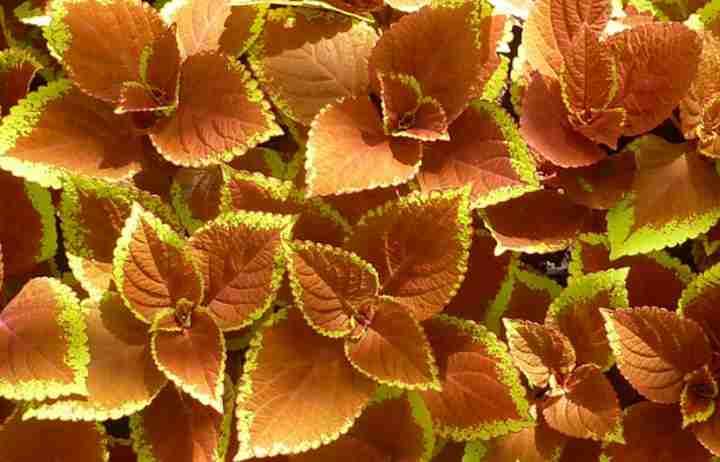
The best time to repot coleus plant is in spring time
Repotting is necessary when your plant becomes rootbound and outgrows its current container. The best time to repot coleus is in spring when plants start growing vigorously. Choose a pot with plenty of drainage holes that is 1” to 2” (2.5 – 5 cm) larger than the current container. If you don’t want your plant to grow larger, repot in a similar-sized one.
Repotting coleus is straightforward. This is how to repot your tropical houseplant:
- Gently prize the coleus from its container and shake off excess soil.
- If necessary, untangle the roots and check for signs of root rot or damage—prune as needed.
- Fill a new container with an appropriate potting mix up to half full.
- Transfer your healthy coleus, making sure it’s planted at the same height as before.
- Top up the pot with potting mix, press the soil around the stems to firm it, and water thoroughly.
- Place in a bright location away from direct sunlight.
Growing Coleus Plant Outdoors
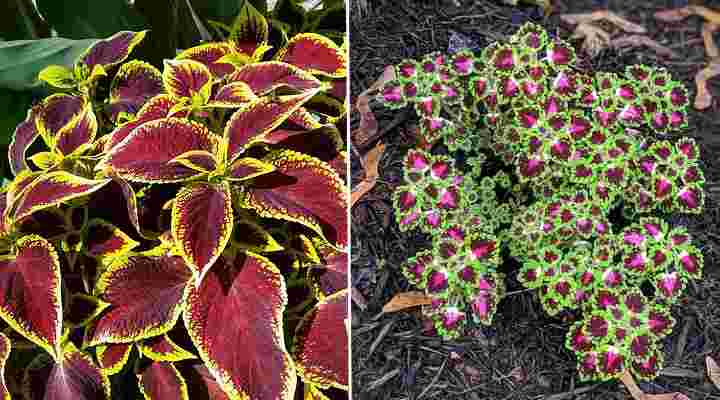
You can grow coleus plant outdoors in temperate climate
In temperate climates, coleus plants grow in yards and garden as annuals. The best time to plant your coleus is in springtime when there is no risk of frost. Choose a bright location in your yard that has partial shade and a few hours of direct morning sunshine. Make sure that water drains away from the growing area.
Soil temperature should be a minimum of 60°F (15°C) if you want success in growing coleus plants outside. If it’s difficult to find a part of your yard that has dappled afternoon shade, choose a dark-leafed variety of coleus. Plants with dark red, deep purple, maroon and burgundy leaves tolerate sun better than lighter-colored leaves.
Regular pruning will help make sure that your coleus grows into a majestic colorful shrubby plant in your garden.
Do coleus like sun or shade?
Coleus plants are known as being shade-loving plants that only need a few hours of sunshine. However, newer coleus cultivars are more tolerant of full sun. Choose a coleus plant for full sun from the ‘Wizard,’ ‘Versa,’ or ‘Marquee’ cultivars.
Also, remember that coleus doesn’t like constant shade. So, plant coleus anywhere in your yard that gets a few hours of sunshine in the morning and dappled shade for the rest of the day.
Are Coleus Plants Toxic?
According to the American Society for the Prevention of Cruelty to Animals (ASPCA), coleus is toxic to cats, dogs, and horses. So, keep your pets away from coleus plants in your yard or at home. (1)
The National Capital Poison Center lists coleus as a non-poisonous plant for humans. However, people with sensitive skin may get skin irritation after handling a plant. (2)
Coleus Plant Care: Common Diseases and Pests
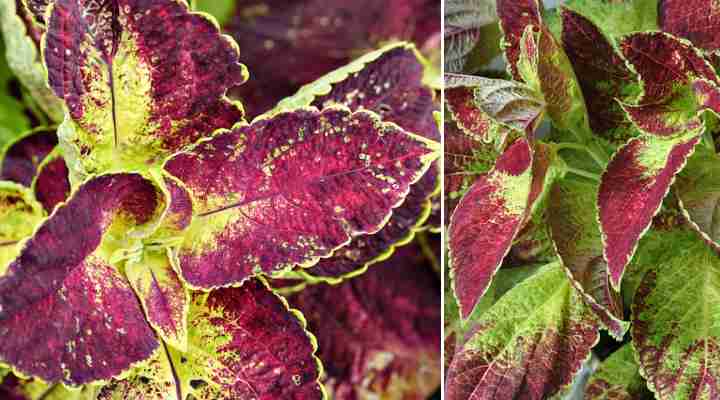
Avoid over-watering you coleus plant to prevent root rot
The best way to care for coleus plants—indoors or outdoors—is to make sure you water them correctly. Because coleus plants need high humidity, moisture issues can cause problems.
The most common disease to afflict these tropical plants is root rot caused by over-watering. If the plant’s roots sit in soggy, mushy soil, they will start to decay and die. Eventually, the plant will turn yellow, wither, and die.
Watering at soil level also helps prevent downy mildew—a fungal disease that affects leaves. If you notice leaves curling or turning gray, cut them off with sterile scissors. Similarly, if you see a white powdery film—a sign of powdery mildew—cut off affected parts of the plant.
The most common pests to infect coleus plants are aphids, spider mites, or mealybugs. Try using an organic neem oil solution as a natural insecticide to get rid of houseplant pests without chemicals.
Common Problems When Growing Coleus Plants

Issues with sunlight or moisture are the most common problems when caring for coleus plants.
Curling leaves are usually the result of mildew, dry air, in adequate humidity, or not enough watering.
Yellowing leaves that start to droop can also be a result of too much water or not enough. Getting scorched in direct sunlight can also cause leaf problems, especially in plants with lighter-colored foliage.
Coleus Plant Varieties
Let’s look briefly at some of the best and most stunning varieties of coleus plants.
Campfire Coleus (Plectranthus ‘Campfire’)
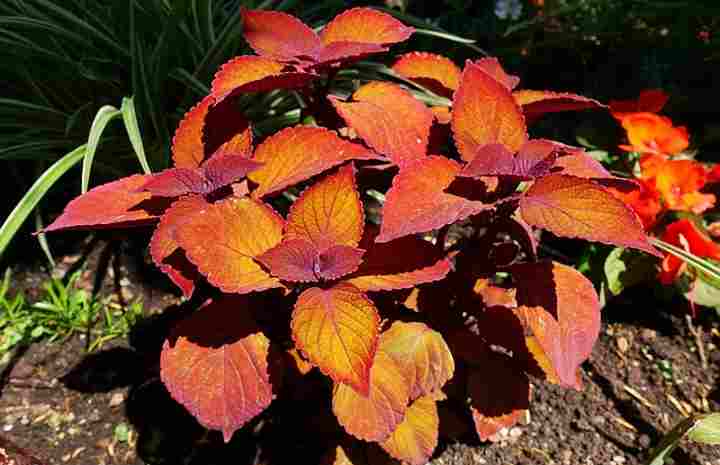
Warm reddish-orange foliage adorns this sun and shade-loving plant. Use for a dramatic effect in your garden to contrast with lighter plants or grow in containers indoors.
Lime Time Coleus (Plectranthus ‘Lime Time’)
This coleus cultivar has bright green leaves that liven up shady corners of your yard. Growing up to 36” (90 cm) tall, this also thrives as a houseplant with the proper pruning.
MainStreet Broadway Coleus (Plectranthus ‘MainStreet Broadway’)
Large purple leaves with lime-green edgings make this coleus an eye-catcher in your garden. This cultivar grows well in partial shade and is sun-tolerant. It only grows up to 18” (45 cm) tall and is perfect for creating colored garden borders, decorate container gardens, or grow in pots indoors.
Redhead Coleus (Plectranthus ‘Redhead’)
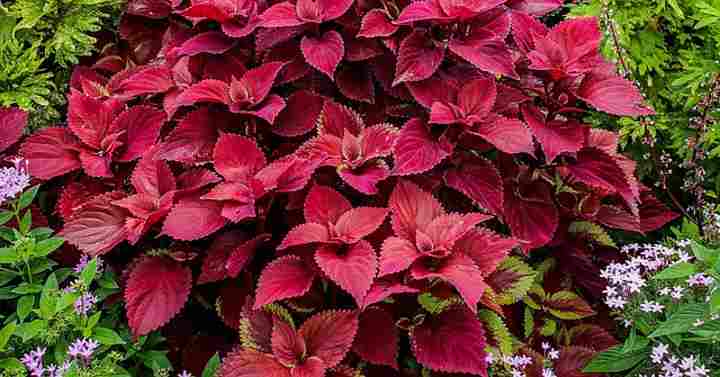
This large shrubby tropical plant has rich reddish-purple foliage and grows well in sunny locations. Use to add bold colors to garden landscapes or grow as a small colorful houseplant.
Trusty Rusty Coleus (Plectranthus ‘Trusty Rusty’)
One of the brightest coleus cultivars with its copper red and yellow variegated foliage. Growing up to 18” (45 cm) tall, the shade-loving coleus will add bright sunshine colors to your yard or container.
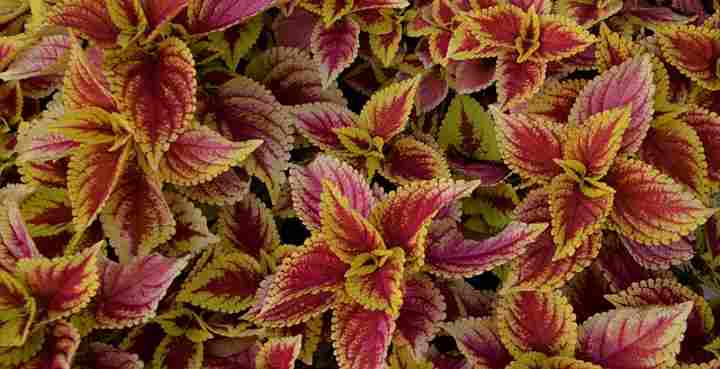
Related articles:
